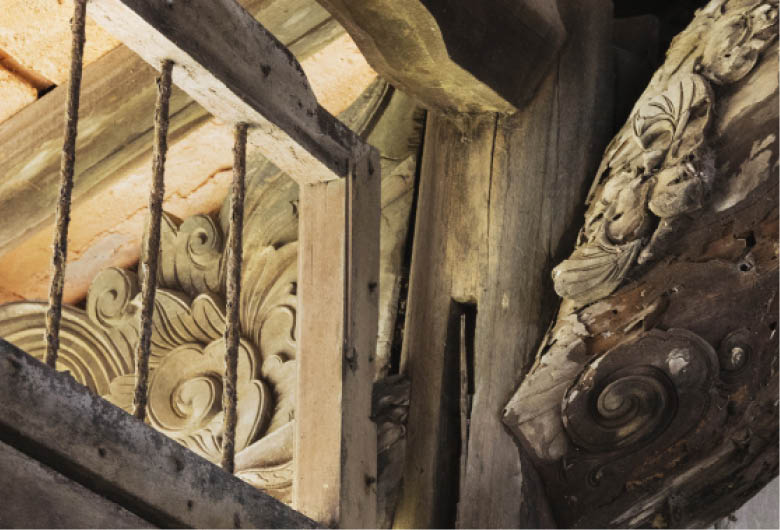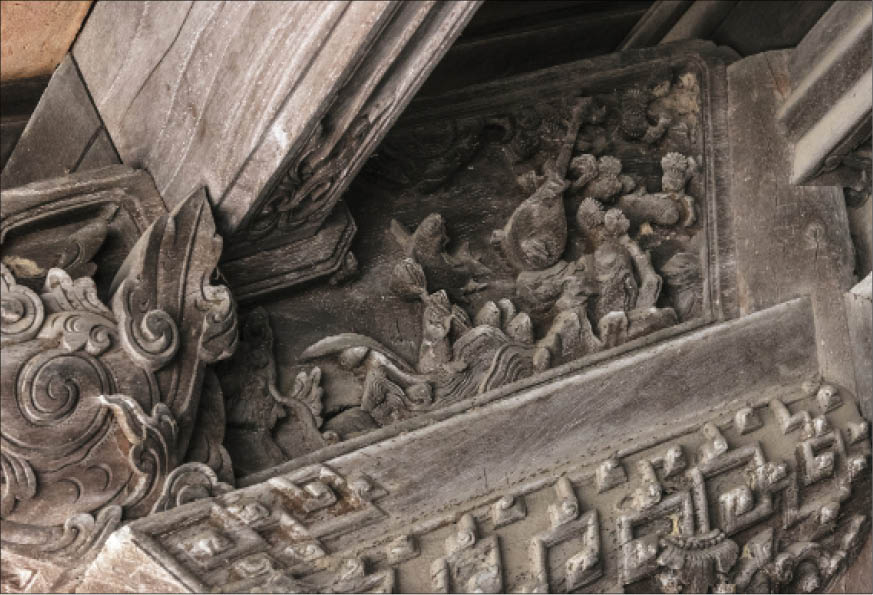
Many relics are “living” with the community but degrading quickly and gradually sinking into oblivion
Space for installation art
The multimedia art project “About Hue” by the team of architects, artists and researchers, both Vietnamese and foreign, is on display at Diem Phung Thi Art Center, Hue Museum of Fine Arts from July 20-29.
Through paintings, photos, maps, articles and sketches, the project introduces the architectural heritage in and around Hue (excluding the Complex of Hue Monuments), which is fading into oblivion, with the hope of creating a connection with those who want to preserve the tangible cultural heritage including architecture and evoking discussion about the conservation of the architectural heritage in the community.
The exhibits are arranged in a way that makes the viewers feel as if they are entering a space with many layers of history through stories about architecture. At the center of the room are the overhead projectors which show photographs of architectural constructions which are fading into oblivion by Archie Pizzini, an American architect.
These projectors are placed in the center of a giant lantern, 2.4m in diameter. The lantern is of two layers. One layer is the map of the Perfume River by Nguyen Yen Phi, the other are drawings in pen on giay do (a special kind of paper) by Ngo Quoc Dung, inspired from his feelings about the architectural constructions in Hue.


Beautiful patterns demonstrate the talent of artisans in the past
When the lights inside the lantern are on, the shadow of the Perfume River is projected on the drawings and the photos. This is the metaphor for layers of Hue cultural history that the team wants to evoke in the viewer.
The overlapped layers of history and the stories by the artists, both real and imaginary, allow the viewer at the same time to live in multiple dimensions of time and space, evoking ideas and memories.
This space is also dedicated to photos of details on constructions and sketches by Urban Sketchers Vietnam. Each photo portrays the carving patterns and the pottery pieces. They are like windows for the viewer to look into the beauty and to admire the talented hands of artisans in the past.
Each photo is accompanied by an article by Tran Van Dung, a researcher from Culture and Sports Board, telling the story about the relic in relation to the history of the city. Dr. Hoanh Tran, a Vietnamese oversea, contributes an article about the theory of architectural and urban conservation, focusing on the basic idea of the exhibition: living relics in cultural life of a city.
Excavating for “cultural sediments”
“About Hue” is a community-based multimedia art project initiated from the idea of Nguyen Yen Phi, a female architect who used to study and work in America for ten years.
Coming back to Vietnam, in a trip to Hue, Phi realized Hue has not only the Imperial City and the royal mausoleums, but also many other architectural constructions which are degrading and sinking into oblivion, especially communal houses and temples. The young woman wants to record their images before they disappear as well as tell other stories about Hue.
The project was implemented in two years. Through Yen Phi’s connection, many other architects and researchers joined the project. They surveyed over 20 villages to select constructions of historical and architectural values built by the community such as Quang Thanh Temple, Mr. Ung Thong’s House, Dai Can Temple, Phuong Duc Church, Ba Temple, etc. which need repairing and conserving.
According to Yen Phi, if the Complex of Hue Monuments is the visible top layer, then there are many other layers which hide themselves somewhere in the city and villages. Many communal houses, temples, ancient houses and colonial constructions are deserted or have been destroyed.
In our field trips for photos and records, we had to find old people because many young people had no idea about the heritage though it is right in their community. We want to excavate part of those “cultural sediments.”
In addition, people often recognize the architectural heritage as separate constructions, but not part of the city or the stories about history and cultural life. With this project, the team wants to bring architecture and conservation closer to people, making them understandable through visual art. Besides raising awareness of the importance of the local architecture, the team also wants to stress the importance of placemaking, the interrelation between architecture and community development, and the connection between cultural history and architecture.
Story and photos: MINH HIEN